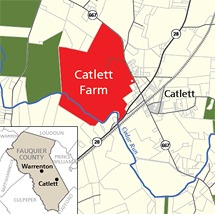Update: After years of consideration and seven public hearings, the Village of Catlett proposal was finally voted down. This over-sized development never made very much sense, but it was kept alive based on a promise from the developer to provide sewer to Catlett at no cost to taxpayers. In the end, the Board realized that was not likely, and turned the project down on a 3 to 2 vote. However, the developer has decided to challenge the denial, so the county and the developer are currently in litigation. We will keep you updated as we find out more.

The proposed development, located north of Rt 28 and west of Old Dumfries Rd, is for 225 single family homes and 45 multifamily units. If built, it would dwarf the existing village of Catlett, which currently has around 125 homes. Usually, rezoning proposals in Virginia are accompanied by proffers that help offset costs incurred by the county, including the cost to provide schools, emergency services, etc. Fauquier County’s suggested cash proffer for a single family detached unit is currently $28,613 per unit, $20,597 for a single family attached unit and $13,158 for a multi-family unit. But the Village of Catlett developer isn’t offering any cash — even though County staff have estimated the County would need to lay out $6.4 million in capital costs for schools alone and an additional $819,570 per year for operating expenses.
The main selling point is the developer’s offer to construct a sewage treatment facility at some point in the future. The catch is, the developer only has to make good on that promise if the sewage collection system is paid for first, at great expense to the county. There’s also an open question about how residents, particularly low-income residents, will pay to hook up to the new system — which could cost up to $20,000 per connection.
The need for a better way to handle sewage in Catlett is a serious issue. However there are more reliable ways to solve the problem. One option is for the County to pay for the system directly. Another option is to pursue the construction of several smaller systems that could be eligible for a wide variety of grants, low interest loans, and tax credits for commercial and residential properties. This option would take a site by site approach, eliminate the need for a collection system, and could be less costly than the other two options.
Please contact Diana Norris ([email protected]), PEC’s Fauquier Field Officer, with any questions.
